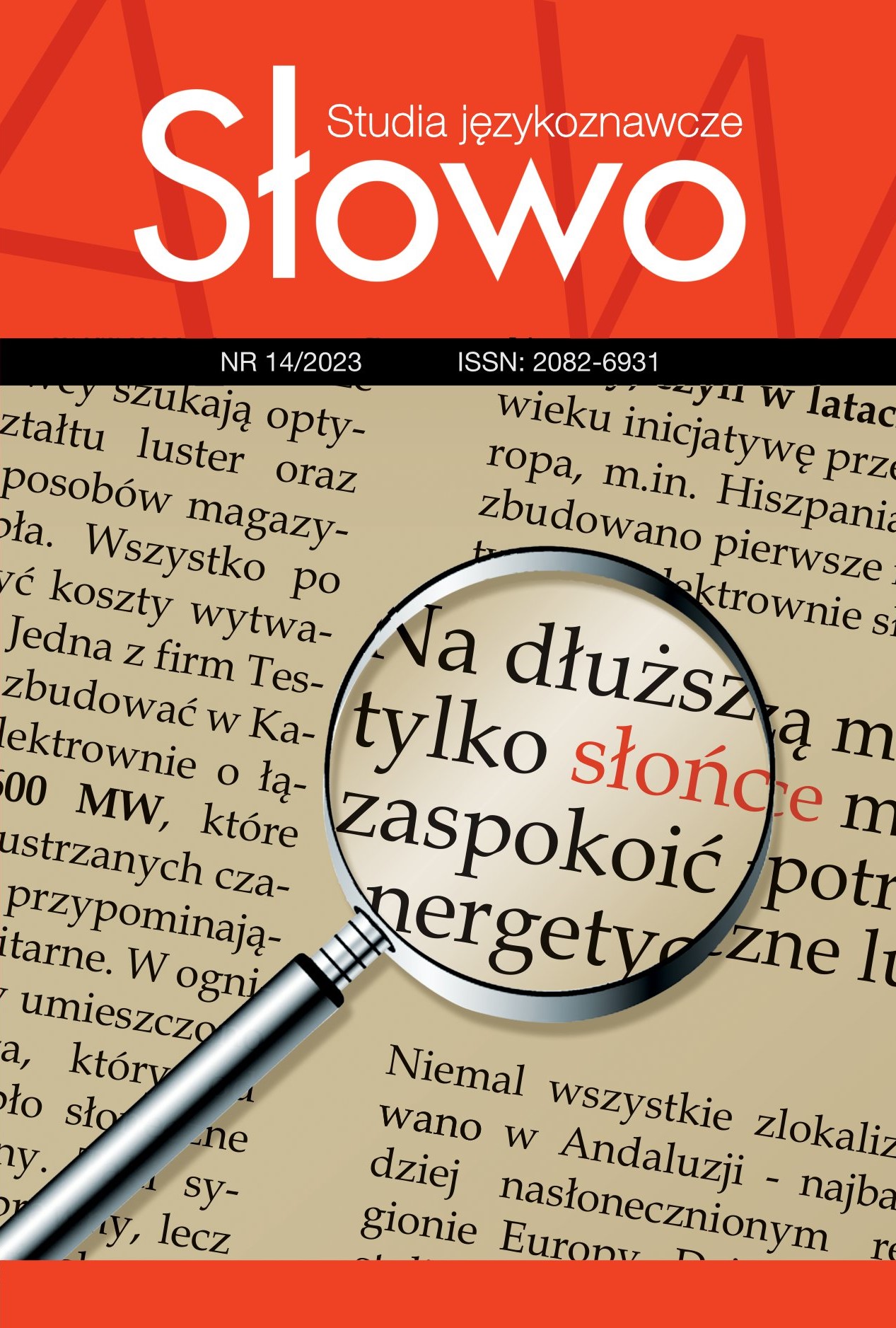The Semantic Frame of The Royal Funeral
DOI:
https://doi.org/10.15584/slowo.2023.14.18Keywords:
cognitive models, semantic frames, Queen Elizabeth II, the frame of ROYAL FUNERAL, the [ROYAL FUNERAL] scriptAbstract
Any form of life ends in death. Human death is a difficult moment for an individual’s family. Various cultures observe diverse rituals and traditions connected with the end of life and perform different burial rites. Memorial services assume a range of forms depending on the culture and religious tradition an individual was brought up in and followed throughout their life. However, memorial ceremonies are also diversified within a given culture. The funeral of a monarch is much more complex as compared to this of any of his/her subject’s. The death of the British Monarch, Queen Elizabeth II, in September 2022 was followed by a period of mourning and state funeral. The analysis in the present paper focuses on the semantic frame of the royal funeral. The methodological framework adopted for the discussion is the cognitive linguistic one, focusing on cognitive-linguistic models such as frames and scripts, exemplified here by the frame of the ROYAL FUNERAL and the [ROYAL FUNERAL] script. Both of the presented models contain unique elements that are not to be found in other contexts. The components of frame and script which are specific to this event are highlighted. The data for the detailed description of the frame are gathered from the online news reports provided by the British Broadcasting Corporation. The study shows how different the discussed model is from the standard description of the frame of FUNERAL and the [FUNERAL] script respectively. Also, many of its elements are culture-specific.
Downloads
References
Allan, K. & Burridge, K. (2006). Forbidden Words. Taboo and Censoring of Language. Cambridge: Cambridge University Press.
Baumel, J. T. (2002). Founding myths and heroic icons: reflections of the funerals of Theodor Herzl and Hannah Szenes. Women’s Studies International Forum. 25(6), 679-695. https://doi.org/10.1016/S0277-5395(02)00349-7
Burkhanov, I. (1998). Lexicography. A Dictionary of Basic Terminology. Rzeszów: Wydawnictwo Wyższej Szkoły Pedagogicznej.
Burkhanov, I. (1999). Linguistic Foundations of Ideography. Semantic Analysis ond Ideographic Dictionaries. Rzeszów: Wydawnictwo Wyższej Szkoły Pedagogicznej.
Collins, W. L. & Doolittle, A. (2006). Personal reflections of funeral rituals and spirituality in a Kentucky African American family. Death Studies. 30(6), 957-969.
Eisenbruch, M. (2021). Diamond Island bridge is falling down: Cultural deathscapes of grief, funeral ceremonies, and continuing bonds after a disaster in Cambodia I - The first days. International Journal of Disaster Risk Reduction. 60(2021), 102275. https://doi.org/10.1016/j.ijdrr.2021.102275
Evans, V. (2007). The Glossary of Cognitive Linguistics. Edinburgh: Edinburgh University Press.
Fillmore, C. J. (1982). Frame semantics. In: The Linguistic Society of Korea, (Ed.), Linguistics in the Morning Calm (pp. 111-137). Seoul: Hanshin Publishing Company.
Fillmore, C. J. & Atkins, B. T. (1992). Toward a frame-based lexicon: The semantics of RISK and its neighbors. In: Lehrer, A. & Kittay, E. F., (Eds.), Frames, Fields, and Contrasts: New Essays in Semantic and Lexical Organization (pp. 75-102). Hillsdale: Lawrence Erlbaum.
Johnson, M. (1987). The Body in the Mind. Chicago & London: University of Chicago Press.
Lakoff, G. (1987). Women, Fire and Dangerous Things: What Categories Reveal About the Mind. Chicago & London: University of Chicago Press.
Lakoff, G. & Johnson, M. (1999). Philosophy in the Flesh. The Embodied Mind and its Challenge to the Western Thought. New York: Basic Books.
Langacker, R. (1987). Foundations of Cognitive Grammar. Volume 1. Theoretical Prerequisites. Stanford: University Press.
Longoria, T. (2014). Are We All Equal at Death?: Death Competence in Municipal Cemetery Management. Death Studies. 38(6-10), 355-364.
Onu, J. O. & Solomon-Etefia, P. O. (2019). A functional-semiotic investigation of traditional funeral rites and rituals in Elugwu Ezike in Igboland. International Journal of Language Studies. 13(1), 99-128.
Schank, R. C. & Abelson, R. P. (1977). Scripts, Plans, Goals and Understanding. Hillsdale: Lawrence Erlbaum.
Taylor, J.R. (1989). Linguistic Categorization: Prototypes in Linguistic Theory. Oxford: Clarendon Press.
Ungerer, F. & Schmid, H-J. (1996). An Introduction to Cognitive Linguistics. London & New York: Longman.
Uberman, A. (2016). Death in metaphorical language. Lege Artis. Language yesterday, today, tomorrow. 1(2), 171-211. DOI: 10.1515/lart-2016-0013
Uberman, A. (2018a). Avoiding to name the unavoidable: euphemisms for the elements of the frame of DEATH. In A. Uberman & M. Dick-Bursztyn, (Eds.), Language in the New Millennium: Applied-linguistic and Cognitive-linguistic Considerations (pp. 179-190). Berlin & New York: Peter Lang.
Uberman, A. (2018b). Frame analysis of the concept of DEATH across cultures. Lege Artis. Language yesterday, today, tomorrow. 3(1), 417-447. DOI: 10.2478/lart-2018-0011
Uberman, A. (2019). Figurative language employing components of the frame of DEATH. In M. Grygiel & R. Kiełtyka, (Eds.), Cognitive Linguistics in the Year 2017 (pp. 35-46). Berlin: Peter Lang.
Queen Elizabeth II has died. https://www.bbc.com/news/uk-61585886 [assessed: 8.09.2022].
Obituary: Queen Elizabeth II. https://www.bbc.com/news/uk-61605149 [assessed: 8.09.2022].
Mourners queue all night to see Queen’s coffin in Edinburgh. https://www.bbc.com/news/uk-scotland-62879795 [assessed: 13.09.2022].
What to know if you want to view Queen’s coffin in Edinburgh. https://www.bbc.com/news/uk-scotland-62876366 [assessed: 13.09.2022].
Queen Elizabeth II: Lying-in-state. https://www.bbc.co.uk/programmes/w172yfc4z0mf hy7 [assessed: 15.09.2022].
William and Harry lead historic coffin vigil. https://www.bbc.com/news/uk-62938463 [assessed: 17.09.2022].
Queen’s children hold sombre watch over Queen’s coffin. https://www.bbc.com/news/uk-62934405 [assessed: 17.09.2022].
Your complete guide to the Queen’s funeral. https://www.bbc.com/news/uk-60617519 [assessed: 19.09.2022].
Queen’s funeral: Full guide to the gun carriage and the main procession. https://www.bbc.com/news/uk-62941422 [assessed: 19.09.2022].
Queen Elizabeth’s funeral: Order of service at Westminster Abbey. https://www.bbc.com/news/uk-62948934 [assessed: 19.09.2022].
The order of service for Queen’s committal at St George’s Chapel at Windsor Castle. https://www.bbc.com/news/uk-62952665 [assessed: 19.09.2022].
The dazzling crown which sat on the Queen’s coff in. https://www.bbc.com/news/uk-england-62906194 [assessed: 19.09.2022].
The personal touches in Her Majesty’s colourful funeral flowers. https://www.bbc.com/news/uk-62954578 [assessed: 19.09.2022].
Queen’s funeral: Flags back at full-mast as mourning period ends. https://www.bbc.com/news/uk-62964166 [assessed: 20.09.2022].
Queen Elizabeth II: Picture of chapel ledger stone released. https://www.bbc.com/news/uk-63020705 [assessed: 24.09.2022].
Downloads
Published
How to Cite
Issue
Section
License
Copyright (c) 2023 Słowo. Studia Językoznawcze

This work is licensed under a Creative Commons Attribution-NonCommercial 4.0 International License.


